How to catch a wave -- on the Sun
Science Nugget: August 27, 1999
1. What's the idea?
It has been difficult for Yohkoh to see global solar atmospheric
waves of the type made famous by Type II bursts, chromospheric Moreton
waves, and coronal EIT waves. The reasons for this have been discussed
a bit in the links associated with the first likely
SXT
observation of a global coronal wave. Soft X-ray observations can bring
new knowledge about wave properties, because of the good response to higher
temperatures, but by golly we need to have more than one wave to work with.
Accordingly last week we have been experimenting with a new program aimed
explicitly at catching waves: we will have SXT make "quarter resolution"
images, ie 10 arc-sec pixels, which it can do every 32 seconds. Thus a
wave moving at 700 km/s (conveniently one arc-sec/s) will cover one pixel
in ten seconds, or three pixels in 32 seconds (approximately). Such good
sampling would in principle give us many images of a given wave, providing
we were lucky enough to be using such a mode when the wave happened, and
did not go automatically into flare mode. So, this science nugget describes
test observations of this sort. Yohkoh has also raised its flare
threshold, at least temporarily, so that we can observe global effects
on events at the C6 level or below - many EIT waves happen with such flares.
2. Data quality - could we see a wave with the new data mode?
So, let's take a look at some images taken in this mode (AlMg filter, exposure
time. It doesn't do much good to look at the movie, because only subtle
variations (including some pointing jitter, which is noticeable even at
this resolution). Instead the images below show three views of a difference
between two consecutive frames (07:10:33 and 07:11:05 UT, August 28, 1999):
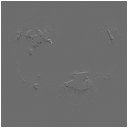
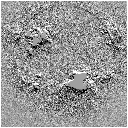
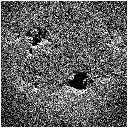
From left to right, these show a direct difference; a difference with
an expanded scale of +-20 DN (for reference, the active-region areas are
saturated at 4,096 DN, so that this expanded scale really is just the faint
parts); and a specially-compressed representation that shows the positive
and negative excursions as separate square roots. In any case, the point
is that there are faint, ghostly features at the level of this +-20 DN
of noise. If a wave passed through the corona and were this bright, the
pattern would clearly be visible. The May
6, 1998 wave had peak brightnesses many times this level, but it came
from an X-class flare. So we don't know exactly what to expect.
A different way to look at these images is via the histogram of the
difference: how many pixels showed what brightness level. Left and right
below, the histograms from one of the images (07:10:33 UT) in a box near
disk center, and from the difference of the two:
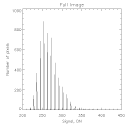
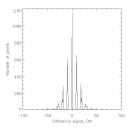
The sort-of-unexpected grouping of the histogram into multiple peaks
shows the presence of the data compression algorithm. Each pixel value
is transmitted essentially as a square root of its value; since the inherent
noise (the photon counting statistics) varies as the square root, this
can be done in such a way as not to compete. So these big gaps in the histogram
in principle don't mean a thing in terms of signal-to-noise ratio.
3. Bottom line
Well (groan) we've done it again! A turgid science nugget with only nuts
and bolts in it. But never fear, you will be so pleased with the wave observations
that result from this new observing mode (when we actually catch a wave,
so to speak in a California way), that you'll be pleased that this explanation
of something relatively technical was there close at hand. But really,
we are killing time this week because the big flare on August 27, which
we observed well, was REALLY DULL:
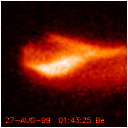

What the SXT image (left) and HXT light curves (right) show us is a
gradual soft-spectrum flare. It had no ejective motions whatsoever, so
far as SXT could see, and no CME either according to the LASCO preliminary
lists, even though it was an M2.8. In the next nugget we'll probably have
excellent observations of the X-class flare later in the day from the same
AR (8674), which did have a halo CME and no doubt will be more fun.
H. Hudson (hudson@isass1.solar.isas.ac.jp)
August 30, 1999